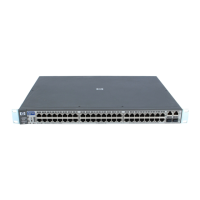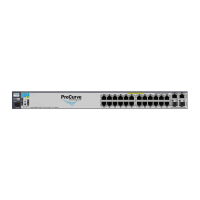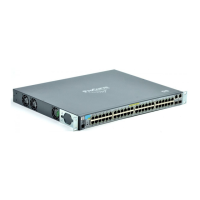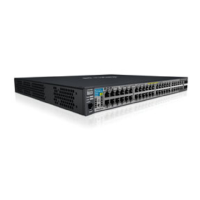9-36
Optimizing Traffic Flow with Port Controls, Port Trunking, and Port-Based Priority
Configuring Port-Based Priority for Incoming Packets
Note For a packet to carry a given 802.1p priority level from end-to-end in a network,
the VLAN for the packet must be configured as tagged on all switch-to-switch
links. Otherwise the tag is removed and the 802.1p priority is lost as the packet
moves from one switch to the next.
Operating Rules for Port-Based Priority on HP Switches
■ In the switch’s default configuration, port-based priority is configured as
“0” (zero) for inbound traffic on all ports.
■ On a given port, when port-based priority is configured as 0 - 7, an inbound,
untagged packet adopts the specified priority and is sent to the corre-
sponding outbound queue on the outbound port. (See table 9-8, “Mapping
Priority Settings to Device Queues”, on page 35.) If the outbound port is
a tagged member of the applicable VLAN, then the packet carries a tag
with that priority setting to the next downstream device.
■ On a given port, when port-based priority is configured as 0 - 7, an inbound,
tagged packet with a priority of 0 (zero) adopts the specified priority and
is sent to the corresponding outbound queue on the outbound port. (See
table 9-8, “Mapping Priority Settings to Device Queues”, on page 35.) If the
outbound port is a tagged member of the applicable VLAN, then the packet
carries a tag with that priority setting to the next downstream device.
■ On a given port, an inbound, tagged packet received on the port with a
preset priority of 0 - 7 in its tag keeps that priority. T and is assigned an
outbound queue on the basis of that priority (regardless of the port-based
priority configured on the port). (Refer to table 9-8, “Mapping Priority
Settings to Device Queues” on page 9-35.)
■ If a packet leaves the switch through an outbound port configured as an
untagged member of the packet’s VLAN, then the packet leaves the switch
without a VLAN tag and thus without an 802.1p priority setting.
■ Trunked ports do not allow non-default (1 - 7) port-based priority settings.
If you configure a non-default port-based priority value on a port and then
add the port to a port trunk, then the port-based priority for that port is
returned to the default "0".
!Software.book Page 36 Thursday, October 10, 2002 6:10 PM

